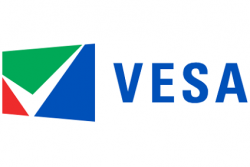VESA was at the show to promote, in particular, the DisplayPort standard which can now take advantage of the latest chips supporting HBR3, which was announce back in 2014, going beyond the previous HBR2 bandwidth level. The HBR3 version of the standard allows up to 32.4Gbps (25.92 Gbps after overhead). The HBR 3 mode supports up to 2160P120 or a single 5K display at 60Hz or dual 2160P60 displays (4:4:4). With compression the 8K 30P HBR3 can be upgraded to 60fps. The group was showing a notebook running dual UltraHD displays at 60P. VESA was highlight at the show that the HBR3 certification programme now includes a full test programme. An event to test HBR 3 solutions was held in Taiwan in December.
HBR3 is the key technology behind DP1.4 which was announced last March.
VESA has been working with the USB group to try to solve some of the challenges of marking USB ports that also support Displayport via the Alt Mode and there is some agreement on marking, now.
Hardent was also on the booth to show its latest Display Stream Compression (DSC) chips and technology. That VESA standard has had a boost from its adoption by HDMI as part of HDMI 2.1 and Hardent told us of subjective tests that have confirmed the quality of DSC.
VESA is looking at the next generation of DSC, to be known as Advanced DSC and which will support 4X to 5X compression, again perceptually lossless, but with more complexity in the electronics needed to support it than in DSC, which provides around 2X compression. There is an expectation that a decision will be made on the technology to be used around the end of Q1 this year, with a released standard by the end of the year.
VESA said that “if you think 8K is the limit, forget it!”. The group has been asked by companies in the VR field to develop interfaces that are looking at dual 11K displays with 120fps and as much as 200 Gbps. As the band said, “You ain’t seen nuthin’ yet!”
Of course, the group was showing that HDR is fully supported, including support of HDMU 2.0b which adds support for HLG signalling.
Also in the VESA booth, was Keyssa, a member company, which has a proprietary short distance 60GHz wireless interface stand that has developed an adaptor to support DisplayPort so that a tablet with DP could connect to a display wirelessly. The dock is low cost and can support connections that are aligned to around 0.5 – 1mm. The company’s technology is starting to be used as the connector between the two halves of convertible PCs. The company told us that it is working on accessories with the Moto group in Lenovo and is the technology is also included on the Acer Switch 12S.

